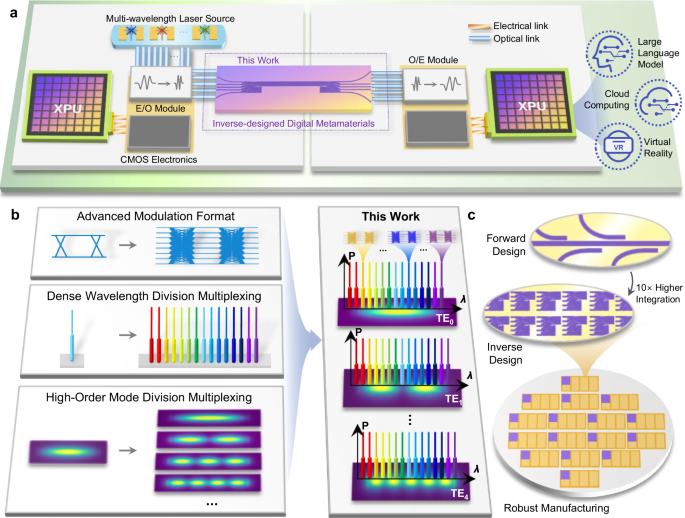Researchers have developed a new method called Edge-Guided Analog-Digital Optimization (EG-ADO) for designing highly efficient and fabrication-robust mode multiplexers (MUXs). These devices are crucial for increasing data capacity in optical communication systems by enabling the transmission of multiple data streams over different spatial modes of light.
The EG-ADO method improves upon traditional design approaches by combining analog optimization for performance with digital optimization for ease of manufacturing. It works in three stages: first, it iteratively optimizes the material structure using an adjoint method to achieve high performance. Second, it employs an edge detection algorithm to convert the optimized analog design into a digital metamaterial design, which is easier to fabricate. This digital conversion also considers the manufacturing constraints of commercial foundries. Finally, a customized binary search algorithm fine-tunes the digital design to maximize performance. This approach significantly reduces computational resources needed for design optimization.
Scientists demonstrated the effectiveness of EG-ADO by designing a five-mode MUX on a standard silicon-on-insulator (SOI) platform. Simulations showed that the designed MUX could efficiently convert fundamental optical modes into the first five higher-order modes, with low loss and crosstalk. Importantly, devices designed with EG-ADO exhibit a linear scaling of computational complexity with the number of modes, a significant improvement over conventional methods that scale quadratically, making it particularly advantageous for complex, high-mode-count devices.
Fabricated four-mode and five-mode MUX devices using electron-beam lithography were tested. Measurements of the four-mode device showed low insertion losses and crosstalk across the C-band of optical communication wavelengths. The five-mode device also demonstrated excellent performance, with flat transmission spectra across the C-band.
To showcase the practical potential, the five-mode MUX was used in a high-speed data transmission experiment. Researchers achieved a transmission rate of 324 Gb/s over a single wavelength using the five modes, resulting in an aggregate data rate of 1.62 Tb/s. Furthermore, in a more complex multi-dimensional transmission experiment combining mode-division multiplexing (MDM) with wavelength-division multiplexing (DWDM) across 88 wavelengths, a record-setting total data rate of 38.2 Tb/s was achieved across 440 channels. This demonstrated the capability of the EG-ADO method and the designed devices for enabling ultra-high-capacity on-chip optical interconnects for future data centers and communication networks. The EG-ADO method and the resulting high-performance, easily fabricable mode multiplexers represent a significant advancement in integrated photonics and hold promise for meeting the growing demand for bandwidth in optical communication systems.

Leave a Reply